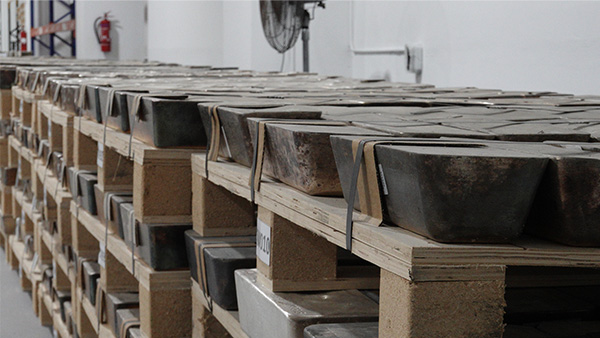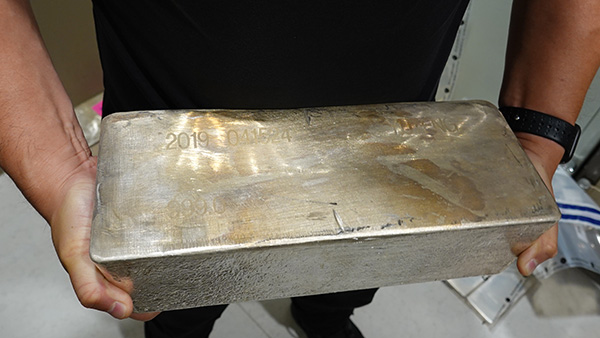How To Clean Silver Bars
Owners of physical bullion like silver coins and bars may find that their silver bullion has accumulated dirt and tarnishes over time. Tarnish, characterized by a dark, sometimes black, coating, is common with silver and is often misinterpreted as a form of corrosion that might degrade the metal. However, rest assured, tarnish is merely a superficial alteration, resulting from a mild reaction with sulfur compounds in the air, and does not permeate deeper layers or diminish the weight and purity of your silver bars. Thus, the intrinsic value remains unaffected, safeguarding your investment.
As one of the premier precious metals dealers in Singapore, having operated for over a decade, we have plenty of first-hand experience with the tons of silver bars that have come our way. Using our experience, we will dispel the myths about silver tarnish and guide you through effective and safe methods to clean and preserve the shine of your silver bars.
Why Silver Tarnish
Like pure gold, pure silver does not rust or corrode. While tarnish is generally considered undesirable due to the loss of aesthetic appeal, it does serve a protective purpose by forming a stable oxide layer that inhibits further oxidation of the underlying silver. This is why silver-plated items, despite having tarnished surfaces, can often retain their structural integrity for long periods.
Silver tarnish is a phenomenon that occurs due to a chemical reaction between silver and sulfur-containing substances in the air, primarily hydrogen sulfide (H2S). When silver is exposed to the atmosphere, it reacts with these sulfur compounds, leading to the formation of silver sulfide (Ag2S), which can appear first as a yellowish coating on the surface of the silver, turning darker over time. This tarnishing process is a form of oxidation, albeit slow and gradual, affecting the outermost layer of the silver object. The tarnish does not typically cause harm to the silver beneath the surface layer, but it does dim the silver bar's lustrous shine and introduce a dark hue.
The process of tarnishing is exacerbated in environments where sulfur compounds are more prevalent, such as in areas with high pollution or in households where items like wool, rubber bands, foods (like eggs and onions), and certain fuels that release sulfur as they decompose or burn are present. Furthermore, the tarnishing process can be accelerated in high humidity and temperature conditions.
Over the years, we have observed different degrees of silver tarnish in our customers' bullion during sellback. For smaller silver bars, some customers tie the bullion with rubber bands in bundles of ten. The rubber bands caused a black band to form on the silver bar despite the bars being kept in plastic sleeves.

Silver tarnish does not affect the value of silver bars
Should Tarnished Silver Bars Be Cleaned?
Before we get into how to clean tarnished silver bars, let's answer the question of whether tarnished investment-grade silver bars should be cleaned. In our opinion, there is no need to, and it is really up to one's preference for keeping silver bars shiny.
What is most important for investment-grade silver bars is their weight and purity (a.k.a. fineness). Since precious metals like silver do not corrode or rust, the intrinsic value of tarnished silver bars is never affected. A 10 troy ounce Royal Canadian Mint silver bar or a 1,000 troy ounce LBMA Good Delivery silver bar will not lose its value just because it is tarnished, even to the point of becoming black.
At Silver Bullion, we welcome customers to sellback their bullion to us, even if they are tarnished. From our perspective, it is the weight and fineness of an investment-grade silver bar that matters.
How Should Tarnished Silver Bars Be Cleaned?
However, if you would still like to clean your tarnished silver bars to restore their shine, there are various methods that are both safe and effective, ensuring that the intrinsic value of the silver is preserved while restoring its aesthetic appeal.
-
Baking soda: One popular method that will not scratch the surface of the silver bars involves cleaning silver with baking soda solution, also known as sodium bicarbonate, and aluminum foil. Simply line a container with aluminum foil, place the silver bars inside, sprinkle baking soda over them, and pour hot water into the container. The ensuing chemical reaction facilitates the transfer of sulfur atoms from the silver to the aluminum, effectively removing the tarnish. After a few minutes, remove the silver bars, gently scrub them with a soft cloth if necessary, and rinse with water before thoroughly drying them.

Cleaning silver with baking soda -
Silver cleaning cloth: Another gentle method to clean silver bars involves using a specialized silver cleaning cloth, impregnated with compounds that help remove tarnish without abrading the silver. Gently rubbing the silver bar with the cloth will gradually remove the tarnish, restoring the silver’s shine without the need for immersion in a solution. Certain newly developed microfiber polishing cloths are crafted from an optimal mix of fibers, proficiently absorbing both oil-based and water-based contaminants with equal efficacy.

Silver cleaning cloth can clean silver jewelry and bars -
Mild soapy water: Alternatively, mild soapy water can also be used as a method for cleaning tarnished silver jewelry and bars. Simply immerse the silver bars in a solution of warm water and a few drops of mild dish soap, gently scrub with a soft cloth and then rinse and dry with a soft cloth thoroughly. You can also wear latex or plastic gloves to prevent oils and dirt from transferring to the bars. Avoid using steel wool or rough brushes, as they can scratch the surface of the silver.
-
Soft eraser: If the tarnish on the silver is light (not heavily tarnished silver) and only has a few spots, you can also use a non-abrasive soft eraser to remove the tarnished areas gently.
It's important to make sure that abrasive materials and harsh chemicals are avoided in the cleaning process to preserve the integrity and appearance of the silver bars. We do not recommend silver polish solutions as they could contain chemicals that may be toxic to you or damage the silver pieces.
Always prioritize methods that have been proven safe for precious metals to ensure the longevity and preservation of your investment. By following these safety precautions and adopting proper cleaning techniques, you can effectively clean your silver bars without risking damage.

Can You Stop Silver From Tarnishing?
Silver is inherently prone to tarnishing due to its chemical properties, and completely preventing this natural process is practically impossible. Silver, regardless if it is sterling silver cutlery, antique silver, or silver plated jewelry, will tarnish when it reacts with sulfur-containing substances in the environment.
Even the mere act of handling silver with bare hands can introduce oils and salts that may hasten tarnishing. Furthermore, the intricate designs and engravings, which are often featured in silver items, can create crevices where tarnish can form, making it even more challenging to prevent.
While it's impossible to prevent tarnish entirely, there is no need to clean your silver pieces frequently, especially if they are investment-grade silver bars, since their value is derived from the silver bar's weight and purity. At the most, your precious silver bars can do with light polishing and the occasional dip in a baking soda wash and dry with a soft microfiber cloth.

